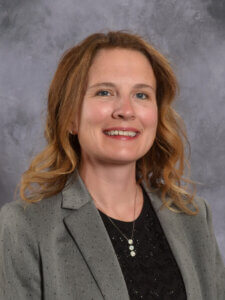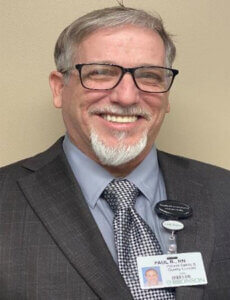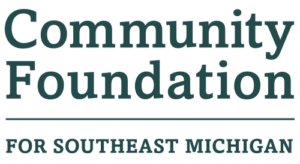
Embracing meticulous data-gathering practices is paramount to documenting the effectiveness of emergency department (ED) medication for opioid use disorder (MOUD) programs. When administered after a nonfatal overdose, buprenorphine can reduce mortality by over 60 percent, according to national statistics. Michigan health systems, such as Bronson Healthcare, are adopting rigorous data collection methods to capture the impact of MOUD programs on local populations and improve care for patients with opioid use disorder (OUD).

Dr. Maureen Ford, emergency medicine physician at Bronson Healthcare
“Through data, we’ve shown that MOUD is safe to start in the emergency department and, when combined with a warm handoff, the best way to get people into treatment,” said Dr. Maureen Ford, emergency medicine physician at Bronson.
As a Michigan Opioid Partnership grantee, the Community Foundation for Southeast Michigan required Bronson to report monthly on ED patients with a diagnosis that matched one or more of 127 OUD-related diagnostic codes provided by the foundation. “During the nine months of our grant, we saw 207 patients in any of our four emergency departments diagnosed with one of those 127 codes. They accounted for 244 ED visits,” according to registered nurse and Bronson’s System Patient and Safety Outcome Coordinator, Paul Bodenberg.

Paul Bodenberg, registered nurse and Bronson’s System Patient and Safety Outcome Coordinator
“We collected demographics, like race, ethnicity, and age, and insurance status. We also tracked the number of buprenorphine doses given in the ED, naloxone kits distributed, prescriptions written for these medications, and consults with social workers and peer recovery coaches,” Dr. Ford said. The hospital worked with community partners to facilitate follow-up care to secure data regarding engagement in treatment 30 and 90 days post-discharge from the ED.
Additionally, Bronson collected data through screening questions for non-prescription opioid use. “Nurses asked a subset of patients 18 and over entering the ED if they were using prescribed or unprescribed opioids and notified a provider if they screened positive,” Dr. Ford continued. “We’d talk with them about their substance use to determine if they were eligible for buprenorphine.” Throughout the nine months of the grant, Bronson nurses conducted screenings on over 40,000 patients using the designated question. Approximately 400 individuals (1 percent) tested positive and were subsequently provided with an opportunity to engage in treatment. “We see on average 15,000 patients monthly in our four EDs; 25 to 35 per month have OUD-related diagnosis system-wide,” said Ford.
Data Impacts Care and Sustainability
Through data, Bronson observed significant improvement in prescribing buprenorphine to people with OUD-related diagnoses. “In January and February, the rate was at 0 percent, but by June, it had increased to approximately 50 to 60 percent. Our goal was not 100 percent because some OUD-related diagnosis shouldn’t be treated with buprenorphine, but we wanted to see improvement, and we did,” Dr. Ford said. The hospital has sustained this prescribing level, closing care gaps for individuals after critical opioid-related events.
Data findings helped create consistency in the ED care team’s procedures. “If we noticed providers were not documenting the Clinical Withdrawal Scale (COWS) score even though they were dosing buprenorphine, we’d remind them to record the score and make sure it was eight or higher to lessen the risk of precipitated withdrawal,” said Dr. Ford. “It’s important to follow the guidelines and document what you used to inform your decision-making.”
Sharing data with partners has also yielded positive results. Upon reviewing the ED team’s protocol for OUD patients not actively withdrawing, community-based addiction specialists made suggestions to simplify Bronson’s discharge prescription. “Patients who do not meet the criteria for a dose of buprenorphine in the ED because their COWS score is too low receive a home start prescription. The doctors recommended changes to the dosage that made it easier for patients to adhere to the instructions for taking the medication,” recalled Dr. Ford.
She went on to say that she is not aware of any instances of precipitated withdrawal when initiating buprenorphine, whether in the ED or inpatient. Although she and Bodenberg are still analyzing some of the data, it appears to underscore that MOUD is safe, with minimal risk and low occurrences of adverse effects.
“It ends up improving care and saving the health system money. Every $1 put into substance use treatment can save society about $7 down the line when you factor in legal and health system related costs,” according to Dr. Ford.
These findings attracted the attention of the hospital’s prioritization committee, which assesses various projects and determines those meriting resources and advancement system-wide. “We are in the growth phase since we were recently selected,” said Bodenberg. “The key lies in garnering support from upper leadership and identifying champions for this work. We’ve recently met with the medical director for the entire system, our vice presidents, and our local community foundation president,” he said. “They are actively collaborating with us to secure additional funding and support to continue this work in the community and hospital units beyond the ED.”
The intention is to extend the MOUD ED-based concepts by establishing a framework that makes healthcare providers throughout Bronson’s system feel confident prescribing buprenorphine and coordinating a seamless handoff for continued care within seven days. “If we can start this safe and indicated medication in the ED, our colleagues in trauma, surgery, and OB can, too,” exclaimed Dr. Ford. “With education on approved dosing protocols, prescribers can be certain they follow evidence-based recommendations.”
Dr. Ford and Bodenberg also work with community partners to gather data illustrating patients’ recovery trajectories. “Access to this information will help us understand who’s still in treatment after 30 or even 90 days. It’ll also help us recognize patients who were in treatment but ended up back in the ED with an opioid-related episode and recommend ways to reengage them in treatment or harm reduction,” Dr. Ford said. She and her team of resident physicians and medical student researchers at the Western Michigan University Homer Stryker School of Medicine are working with the Department of Biomedical Informatics to create a registry of people with OUD so they can follow and improve care for these high-risk patients.
Advice for the Field
“For other hospitals trying to develop ED MOUD programs and data collection initiatives, I think it’s crucial to highlight the importance of holding monthly ED MOUD meetings to share information with the whole team—the ED clinical champions, recovery coaches, community substance use disorder treatment providers, addiction specialists—anyone interested,” advised Dr. Ford. “This allows for consistent feedback and improvement, fostering communication and problem-solving.”
She suggested health systems look to peers for assistance before re-creating the wheel. “Everything we have adopted to support this work, including the ED buprenorphine dosing protocol, resource packet with references and education links for prescribers, EPIC order sets, and screening questions were adapted from other health systems that had done this work before us,” Dr. Ford said.
She and Bodenberg are considering writing a publication that outlines how community-based hospitals can effectively implement ED MOUD programs. “Our results are encouraging, having written 95 prescriptions in just nine months, surpassing historical numbers. This achievement is particularly noteworthy, and we are keen on sharing our experiences to show that hospitals like ours can make significant strides in this area even if they don’t have a bridge clinic,” affirmed Dr. Ford. This is especially pertinent because much of the current literature focuses on larger academic-affiliated health systems with low-barrier walk-in access to addiction medicine clinics.
According to Bodenberg, documenting outcomes is only one element of creating and sustaining a MOUD program. “Using data to guide decisions is vital to success,” he said. “Dr. Ford’s passionate advocacy is another integral piece. You can’t overlook the champions’ role in propelling this work forward.”
